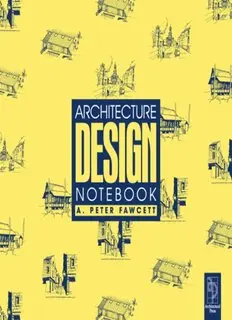
Architecture: Design Notebook PDF
Preview Architecture: Design Notebook
ARCHITECTURE : DESIGN NOTEBOOK ForKaren ARCHITECTURE : DESIGN NOTEBOOK 2nd edition A. Peter Fawcett (Illustratedbytheauthor) ArchitecturalPress AMSTERDAM BOSTON HEIDELBERG LONDON NEWYORK OXFORD PARIS SANDIEGO SANFRANCISCO SINGAPORE SYDNEY TOKYO ArchitecturalPress AnimprintofElsevier LinacreHouse,JordanHill,OxfordOX28DP 200WheelerRoad,Burlington,MA01803 Firstpublished1998 Secondedition2003 Reprinted2003 Copyright#1998,2003,PeterFawcett.Allrightsreserved TherightofPeterFawcetttobeidentifiedastheauthorofthiswork hasbeenassertedinaccordancewiththeCopyright,Designsand PatentsAct1988 Nopartofthispublicationmaybereproducedinanymaterialform(including photocopyingorstoringinanymediumbyelectronicmeansandwhether ornottransientlyorincidentallytosomeotheruseofthispublication)without thewrittenpermissionofthecopyrightholderexceptinaccordancewiththe provisionsoftheCopyright,DesignsandPatentsAct1988orunderthetermsof alicenceissuedbytheCopyrightLicensingAgencyLtd,90TottenhamCourtRoad, London,EnglandW1T4LP.Applicationsforthecopyrightholder’swritten permissiontoreproduceanypartofthispublicationshouldbeaddressed tothepublisher PermissionsmaybesoughtdirectlyfromElsevier’s TechnologyRightsDepartmentinOxford,UK:phone(+44) (0)1865843830;fax:(+44)(0)1865853333;e-mail: [email protected] requeston-lineviatheElsevierhomepage(http://www.elsevier.com), byselecting‘CustomerSupport’andthen‘ObtainingPermissions’. BritishLibraryCataloguinginPublicationData AcataloguerecordforthisbookisavailablefromtheBritishLibrary Fawcett,A.Peter Architecture:designnotebook(cid:1)2ndedn. 1.Architecturaldesign I.Title 721 LibraryofCongressCataloguinginPublicationData AcataloguerecordforthisbookisavailablefromtheLibraryofCongress ISBN0750656697 TypesetbyKeywordTypesettingServicesLimited PrintedandboundinGreatBritain CONTENTS 1 PREAMBLE 1 2 THE CONTEXT FOR DESIGN 3 3 ARRIVING AT THE DIAGRAM 13 RESPONDING TO THE SITE 13 CHOOSING AN APPROPRIATE ‘MODEL’ 16 ORGANISING THE PLAN 23 4 CHOOSING APPROPRIATE TECHNOLOGIES 39 STRUCTURE 39 SERVICES 42 HOW WILL IT STAND UP? 43 HOW IS IT MADE? 51 WILL IT BE COMFORTABLE? 58 WILL IT BE GREEN? 62 5 HOW WILL IT LOOK? 71 EXPRESSION V SUPPRESSION 71 vi Contents ROOF 74 OPENINGS 77 ELEVATIONS 77 WALL MEMBRANES 78 THE CORNER 81 SCALE 83 6 THE SPACES AROUND 93 CENTRIFUGAL AND CENTRIPETAL SPACE 93 URBAN SPACE TYPOLOGY 101 7 POSTSCRIPT: A WORKING METHOD 107 TRADITION V THE VIRTUAL BUILDING 107 FURTHER READING 111 1 PREAMBLE As we enter the twenty-first century, it has designer in the right direction towards prose- become fashionable to consider architecture cuting an acceptable architectural solution. through a veil of literature. Such was not This book, then, attempts to offer that support always the case; indeed, it could be argued bynotonlyoffering someaccepted maxims or that the practice of architecture has rarely design orthodoxies, but also by suggesting been underpinned by a close correspondence how they can inform crucial decisions which with theory, and that designers have been facethearchitectengagedintheactofdesign- drawnmoretoprecedent,toseminalbuildings ing. The text is non-theoretical and therefore and projects rather than to texts for a creative makes no attempt to add to the ample litera- springboard to their fertile imaginations. This ture surrounding architectural theory; rather it ismerelyanobservationandnotanargument aims to provide students engaged in building against fledgling building designers adopting design with a framework of accepted ways of even the simplest of theoretical positions; nor lookingatthingswhichwillsupportandinform does it deny the profound influence of a small theirexperimentandexplorationduringtheso- numberofseminaltextsuponthedevelopment called ‘design process’. oftwentieth-centuryarchitecture,fortherehas Theplethoraofliteratureconcernedwiththe beenaclosecorrespondencebetweensomeof ‘design process’ or ‘design methodology’ is a those texts and icons which emerged as the fairly recent phenomenon which gained built outcome. momentum during the late 1950s. In these But even the most basic theoretical stance early explorations design was promulgated mustbesupported in turn by a few fundamen- as a straightforward linear process from ana- tal maxims which can point the inexperienced lysis via synthesis to evaluation as if conform- 2 Architecture: Design Notebook ing to some universal sequence of decision- dimensional organisation would be config- making. Moreover, design theorists urged uredinplanandsection,representedinreality designerstodelayaslongaspossiblethecrea- an early, if tentative, creative response to any tive leap into ‘form-making’ until every aspect architectural problem. ofthearchitecturalproblemwasthoughttobe The act of designing clearly embraces at its clearly understood. But every practising archi- extremeslogicalanalysisontheonehandand tectknewthatthisrestrictivelinearmodelofthe profoundcreativethoughtontheother,bothof design process flew in the face of all shared which contribute crucially to that central experience; the reality of designing did not ground of ‘form-making’. It is axiomatic that conform to a predetermined sequence at all all good buildings depend upon sound and but demanded that the designer should skip imaginative decisions on the part of the between various aspects of the problem in designer at these early stages and how such any order or at any time, should consider sev- decision-making informs that creative ‘leap’ eralaspectssimultaneouslyor,indeed,should towards establishing an appropriate three- revisitsomeaspectsinacyclicalprocessasthe dimensional outcome. problem became more clearly defined. These initial forays into ‘form-making’ Furthermore,theexperienceofmostarchitects remain the most problematic for the novice was that a powerful visual image of their and the experienced architect alike; what fol- embryonic solution had already been formed lows are a few signposts towards easing a earlyoninthedesignprocess,suggestingthat fledgling designer’s passage through these fundamentalaspectsof‘form-making’suchas potentially rough pastures. how thebuilding would look,or how its three- 2 THE CONTEXT FOR DESIGN It’s a hoary old cliche´ that society gets the like, for example, mechanical engineering architecture it deserves, or, put more extre- (which,incidentally,thrivedundertotalitarian- mely, that decadent regimes will, ipso facto, ism). produce reactionary architecture whilst only This brings us to another well-worn stance democracies will support the progressive. But adopted by progressive architects; that archi- to a large extent post-Versailles Europe bore tecture (unlike mechanical engineering) this out; the Weimar Republic’s fourteen-year respondsinsomemeasuretoaprevailingcul- lifespan coincided exactly with that of the turalclimateinwhichitiscreatedandtherefore Bauhaus,whoseprogressiveaimsitendorsed, emerges inevitably as a cultural artefact and modern architecture flourished in the reflecting the nature of that culture. Certainly fledgling democracy of Czechoslovakia. But the development of progressive architecture the rise of totalitarianism in inter-war Europe during its so-called ‘heroic’ period after the soonputanendtosuchworthyambitionandit First World War would seem to support this waslefttothefreeworld(andmostparticularly claim; architects found themselves at the theNewWorld)toprosecutethenewarchitec- heart of new artistic movements throughout ture until a peaceful Europe again prevailed. Europe like, for example, Purism in Paris, De Thisis,ofcourse,agrossover-simplification Stijl in Rotterdam, Constructivism in Moscow but serves to demonstrate that all architects or the Bauhaus in Weimar and Dessau. work within an established socio-political Inevitably, such movements generated a frameworkwhich,toagreaterorlesserextent, close correspondence between architecture inevitablyencouragesorrestrictstheircreative and the visual arts so that architects looked impulses, a condition which would not neces- naturally to painters and sculptors for inspira- sarilyobtainwithsomeotherdesigndisciplines tionintheirquestfordevelopingnewarchitec-
